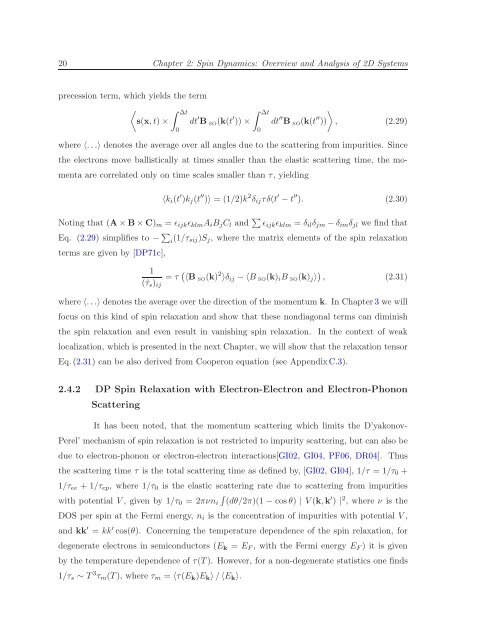Itinerant Spin Dynamics in Structures of ... - Jacobs University
Itinerant Spin Dynamics in Structures of ... - Jacobs University
Itinerant Spin Dynamics in Structures of ... - Jacobs University
Create successful ePaper yourself
Turn your PDF publications into a flip-book with our unique Google optimized e-Paper software.
20 Chapter 2: <strong>Sp<strong>in</strong></strong> <strong>Dynamics</strong>: Overview and Analysis <strong>of</strong> 2D Systems<br />
precession term, which yields the term<br />
〈<br />
s(x,t)×<br />
∫ ∆t<br />
0<br />
dt ′ B SO (k(t ′ ))×<br />
∫ ∆t<br />
0<br />
〉<br />
dt ′′ B SO (k(t ′′ )) , (2.29)<br />
where 〈...〉 denotes the average over all angles due to the scatter<strong>in</strong>g from impurities. S<strong>in</strong>ce<br />
the electrons move ballistically at times smaller than the elastic scatter<strong>in</strong>g time, the momenta<br />
are correlated only on time scales smaller than τ, yield<strong>in</strong>g<br />
〈k i (t ′ )k j (t ′′ )〉 = (1/2)k 2 δ ij τδ(t ′ −t ′′ ). (2.30)<br />
Not<strong>in</strong>g that (A×B×C) m = ǫ ijk ǫ klm A i B j C l and ∑ ǫ ijk ǫ klm = δ il δ jm −δ im δ jl we f<strong>in</strong>d that<br />
Eq. (2.29) simplifies to − ∑ i (1/τ sij)S j , where the matrix elements <strong>of</strong> the sp<strong>in</strong> relaxation<br />
terms are given by [DP71c],<br />
1<br />
(ˆτ s ) ij<br />
= τ ( 〈B SO (k) 2 〉δ ij −〈B SO (k) i B SO (k) j 〉 ) , (2.31)<br />
where 〈...〉 denotes the average over the direction <strong>of</strong> the momentum k. In Chapter3 we will<br />
focus on this k<strong>in</strong>d <strong>of</strong> sp<strong>in</strong> relaxation and show that these nondiagonal terms can dim<strong>in</strong>ish<br />
the sp<strong>in</strong> relaxation and even result <strong>in</strong> vanish<strong>in</strong>g sp<strong>in</strong> relaxation. In the context <strong>of</strong> weak<br />
localization, which is presented <strong>in</strong> the next Chapter, we will show that the relaxation tensor<br />
Eq.(2.31) can be also derived from Cooperon equation (see AppendixC.3).<br />
2.4.2 DP <strong>Sp<strong>in</strong></strong> Relaxation with Electron-Electron and Electron-Phonon<br />
Scatter<strong>in</strong>g<br />
It has been noted, that the momentum scatter<strong>in</strong>g which limits the D’yakonov-<br />
Perel’ mechanism <strong>of</strong> sp<strong>in</strong> relaxation is not restricted to impurity scatter<strong>in</strong>g, but can also be<br />
due to electron-phonon or electron-electron <strong>in</strong>teractions[GI02, GI04, PF06, DR04]. Thus<br />
the scatter<strong>in</strong>g time τ is the total scatter<strong>in</strong>g time as def<strong>in</strong>ed by, [GI02, GI04], 1/τ = 1/τ 0 +<br />
1/τ ee + 1/τ ep , where 1/τ 0 is the elastic scatter<strong>in</strong>g rate due to scatter<strong>in</strong>g from impurities<br />
∫<br />
with potential V, given by 1/τ 0 = 2πνn i (dθ/2π)(1 − cosθ) | V(k,k ′ ) | 2 , where ν is the<br />
DOS per sp<strong>in</strong> at the Fermi energy, n i is the concentration <strong>of</strong> impurities with potential V,<br />
and kk ′ = kk ′ cos(θ). Concern<strong>in</strong>g the temperature dependence <strong>of</strong> the sp<strong>in</strong> relaxation, for<br />
degenerate electrons <strong>in</strong> semiconductors (E k = E F , with the Fermi energy E F ) it is given<br />
by the temperature dependence <strong>of</strong> τ(T). However, for a non-degenerate statistics one f<strong>in</strong>ds<br />
1/τ s ∼ T 3 τ m (T), where τ m = 〈τ(E k )E k 〉/〈E k 〉.
















